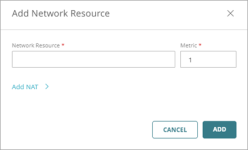Applies To: Cloud-managed Fireboxes
To configure a BOVPN between two cloud-managed Fireboxes in the same WatchGuard Cloud account, you create a shared BOVPN configuration. When you add or update a BOVPN between two cloud-managed Fireboxes, the BOVPN configuration settings automatically deploy for both Fireboxes to download.
To configure a BOVPN between cloud-managed Fireboxes that are not in the same WatchGuard Cloud account, you must configure the BOVPN separately for each Firebox. For more information, go to Configure a BOVPN to a Locally-Managed Firebox or Third-Party VPN Endpoint.
When you add a BOVPN between two cloud-managed Fireboxes, you configure:
- VPN Gateways — The external networks the two devices use to connect.
- Certificate — (Optional) An IPSec Firebox certificate used for tunnel authentication. For more information, go to Certificates for Branch Office VPN (BOVPN) Tunnel Authentication in Fireware Help.
- NAT — (Optional) When you create a BOVPN tunnel between two networks that use the same private IP address range, an IP address conflict occurs. To create a tunnel without this conflict, for each endpoint, you can add NAT to the VPN. NAT creates a map from one or more IP addresses in one range to a second IP address range of the same size. Each IP address in the first range corresponds to an IP address in the second range.
- Network Resources — The networks that can send and receive traffic through the tunnel.
- Virtual IP Address — (Optional) Required if you want to:
- Add the BOVPN to an SD-WAN action.
- Configure a zero-route BOVPN.
- Reply to Firebox-generated traffic through the tunnel. For example, DNS and DHCP traffic, Dimension, syslog, SNMP, NTP, authentication (Active Directory, LDAP, and RADIUS), and other connections established by the Firebox to resources through the tunnel.
In Fireware v12.9 and higher, Firebox IP spoofing check behavior is changed and the Firebox now drops traffic sourced from a second External interface as a spoofing attack. Spoofing checks also apply to BOVPN Virtual Interfaces, and if you do not have BOVPN virtual interface IP addresses configured, the traffic appears to come from the public IP of the remote endpoint. For more information about this change in spoofing check behavior, go to the WatchGuard Knowledge Base.
- Enable Don't Fragment (DF) Bit Settings — (Optional) Control whether the Firebox uses the original DF bit setting in the header of a packet.
- Configure Tunnel MTU — (Optional) Use a custom maximum transmission unit (MTU).
All VPN security settings are configured with the same settings automatically so that the devices can establish a connection.
BOVPNs and Routing
In the BOVPN configuration, you specify what network resources are accessible through the BOVPN tunnel. The resources you select for one endpoint become static routes on the other endpoint, with the BOVPN as the gateway. The distance (metric) you specify for each resource appears in the routing table. The Firebox uses the routing table to determine whether to send traffic through the BOVPN tunnel.
If you want to specify network resources for both endpoints in the same subnet, you must use NAT. If you do not use NAT, you cannot route traffic through a BOVPN tunnel between private networks that use the same IP address range.
For a VPN between a Firebox and a locally-managed or third-party VPN endpoint:
- The network resources you specify for the remote endpoint specify what traffic the Firebox routes through the tunnel. These become static routes on the cloud-managed Firebox, with the BOVPN as the gateway.
- The network resources you specify for the Firebox are the resources that you want the remote endpoint to route through the VPN tunnel to the Firebox. The resources you specify here do not limit what traffic the Firebox accepts through the VPN tunnel. For the Firebox to receive VPN traffic to these resources, the remote endpoint must be configured to route traffic to these IP addresses through the tunnel.
Virtual IP Addresses
A virtual IP address is an IP address that is not tied to a physical interface. For a BOVPN in WatchGuard Cloud, which is a BOVPN virtual interface, a virtual IP address functions as the gateway (next hop). The virtual IP address is used for Firebox-generated traffic and response traffic sent directly to the BOVPN virtual interface.
You must configure virtual IP address in these cases:
SD-WAN
Before you can add a BOVPN to an SD-WAN action, you must configure the BOVPN with /32 virtual IP addresses for both endpoints. BOVPN link monitoring is implicitly enabled when you configure /32 host IP addresses as the virtual IP address of both endpoints. A BOVPN that does not have link monitoring enabled (does not have valid /32 virtual IP addresses for both endpoints) is not available to select in an SD-WAN action.
For more information about SD-WAN, go to Configure SD-WAN.
Zero Routing
If you add a zero route BOVPN network resource (0.0.0.0/0), this creates a default route that sends all network traffic (including the traffic to WatchGuard Cloud) through the VPN tunnel. For a cloud-managed Firebox, you must enter virtual IP addresses in the BOVPN configuration so that return traffic uses the VPN tunnel.
If you add a zero route BOVPN network resource, and the remote VPN endpoint cannot route traffic from the cloud-managed Firebox to WatchGuard Cloud, you lose the ability to manage or monitor the Firebox.
Firebox-Generated Traffic
The Firebox itself generates traffic through the tunnel. Firebox-generated traffic is also known as self-generated traffic or self-originated traffic.
You must enter a /32 virtual IP address for each endpoint so that replies to Firebox-generated traffic use the VPN tunnel. Do not use the IP address elsewhere on the Firebox. You do not have to use an IP address from within the tunnel routes. Examples of Firebox-generated traffic include DNS and DHCP traffic, Dimension, syslog, SNMP, NTP, authentication (Active Directory, LDAP, and RADIUS), and other connections established by the Firebox to resources through the tunnel.
BOVPNs and Automatic Deployment
When you add, edit, or remove a BOVPN, WatchGuard Cloud automatically creates a new deployment for both Fireboxes to download. For each Firebox, the automatic deployment contains updated BOVPN settings. To make sure that the automatic deployment contains only BOVPN configuration changes, you cannot save BOVPN changes if either device has other undeployed configuration changes.
Before you add, edit, or remove a BOVPN for two Fireboxes in the same account, make sure that neither Firebox has undeployed changes.
Add a BOVPN Between Cloud-Managed Fireboxes in the Same Account
You can add a BOVPN from the BOVPN page for a specific Firebox, or you can add it from the VPNs page, which is a shared configuration page. For more information, go to Manage BOVPNs for Cloud-Managed Fireboxes.
To add a BOVPN, from WatchGuard Cloud:
- To open the BOVPN page, use one of these methods:
- To manage BOVPNs for all Fireboxes in the currently selected account, select Configure > VPNs.
- To manage BOVPNs for a specific Firebox, on the Device Configuration page, click the Branch Office VPN tile.
- From either BOVPN page, click the Branch Office VPN tile.
The BOVPN page shows currently configured BOVPNs.
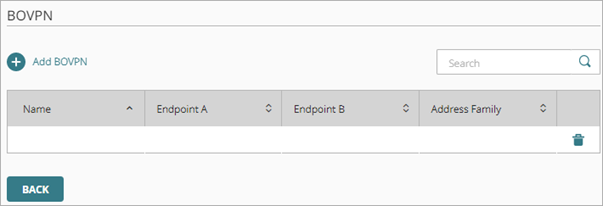
- Click Add BOVPN.
The Add BOVPN page opens.
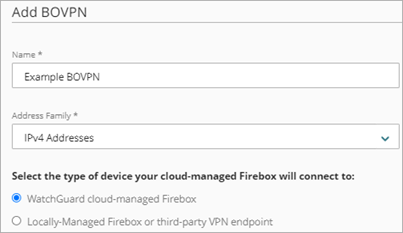
- In the Name text box, type a name for this BOVPN.
- From the Address Family drop-down list, select IPv4 Addresses or IPv6 Addresses.
If you select IPv6 Addresses, the other BOVPN endpoint must be configured to support IPv6. - Select the option to connect to a WatchGuard cloud-managed Firebox.
With this option, both Endpoint A and Endpoint B sections contain a list of Fireboxes.

- In the Endpoint A section, select a cloud-managed Firebox in your account.
If you added the BOVPN from a Device Configuration page, the Endpoint A list contains only one Firebox. - In the Endpoint B section, select another cloud-managed Firebox in this account.
The Endpoint B list shows all cloud-managed Fireboxes in the same account. - Click Next.
The VPN Gateways page shows the option to use an IPSec Firebox certificate and a list of external networks on each Firebox.

- (Optional) To use an IPSec Firebox certificate for this VPN connection:
- Select Use IPSec Firebox Certificate.
A certificate list appears. - Select a certificate.
- Select Use IPSec Firebox Certificate.
- For each endpoint, select at least one external network the endpoints use to connect.
- For each network you select, specify the IP address or a domain name that resolves to the Firebox external network IP address.
- If you select more than one network for an endpoint, the Order determines which network is primary. To change the network order, click the move handle for a network and drag it higher or lower in the list.
- Click Next.
The Traffic settings page shows the internal and guest networks configured on each device.
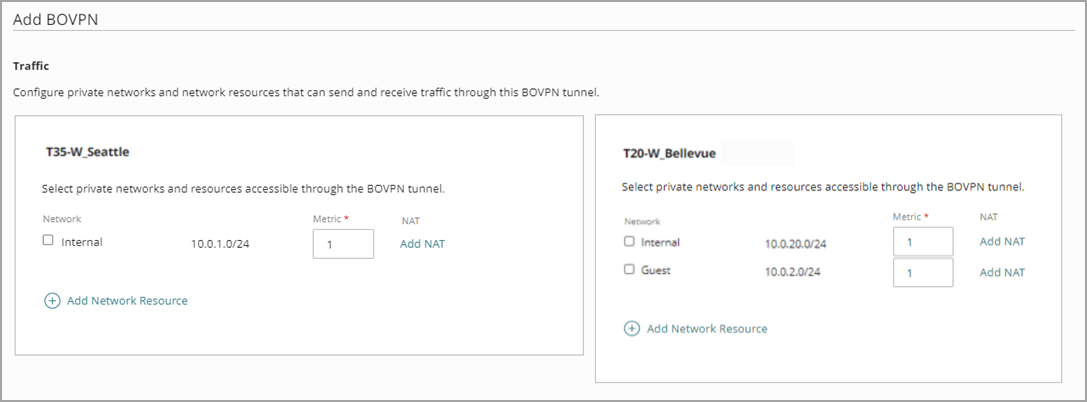
- For each endpoint, select internal or guest networks that can send and receive traffic through this tunnel.
- (Optional) To avoid conflicts when both networks use the same private IP address range, add NAT to each endpoint:
- Next to the first network endpoint you want to add a NAT to, click Add NAT.
The Add NAT dialog box opens. - In the NAT text box, type an IP address and netmask for the NAT.

- Click Add.
The NAT information shows next to the network endpoint entry. - Repeat Steps a — c to add NAT to the second endpoint.
- Next to the first network endpoint you want to add a NAT to, click Add NAT.
To remove a NAT IP address, edit the NAT text box to be empty and click Save.
When you configure NAT between two cloud-managed Fireboxes in the same WatchGuard Cloud account, add NAT to each endpoint.
- To specify a network resource other than internal or guest networks:
- In the Network Resource text box, type the network IP address and netmask.Tip!
- In the Distance text box, enter a value between 1 and 254. Routes with lower metrics have higher priority. The default is 1. In Fireware v12.9 or higher, the Distance setting replaces the Metric setting.
- (Optional) To add NAT to a network resource:
- Click Add NAT.
- In the NAT text box, type an IP address and netmask for the NAT.
The netmask used in the NAT text box must match the netmask of the network resource.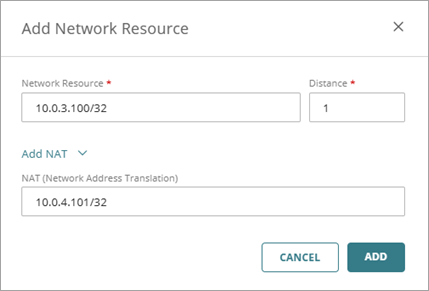
- Click Add NAT.
- Click Add.
The network resource is added to the Traffic settings for the endpoint.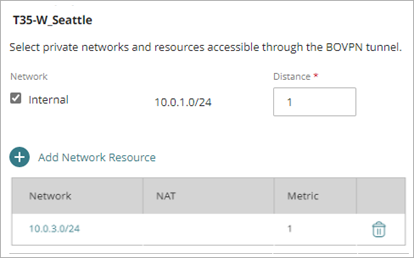
- (Optional) For each endpoint, in the Virtual IP Address text box, type an IP address. A virtual IP address is an IP address that is not tied to a physical interface. For a BOVPN in WatchGuard Cloud, which is a BOVPN virtual interface, a virtual IP address functions as the gateway (next hop). The virtual IP address is used response traffic sent directly to the BOVPN virtual interface.
Virtual IP addresses are required in some cases:
- Before you can add this BOVPN to an SD-WAN action, you must specify virtual IP addresses with a /32 netmask.
- If you configure a zero-route BOVPN, you must enter virtual IP addresses so that return traffic uses the VPN tunnel. If you add a zero route BOVPN network resource, and the remote VPN endpoint cannot route traffic from the cloud-managed Firebox to WatchGuard Cloud, you lose the ability to manage or monitor the Firebox.
- For Firebox-generated traffic, virtual IP addresses are required so those response traffic uses the VPN tunnel. Examples of Firebox-generated traffic include DNS and DHCP traffic, Dimension, syslog, SNMP, NTP, authentication (Active Directory, LDAP, and RADIUS), and other connections established by the Firebox to resources through the tunnel.

- (Optional) For each endpoint, you can select Enable Don't Fragment (DF) Bit Settings. The DF bit is a flag in the header of a packet. This setting controls whether the Firebox uses the original DF bit setting in the header of a packet.
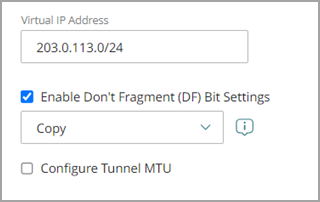
From the Enable Don't Fragment (DF) Bit Settings drop-down list, select one of these options:
Copy
Copies the original DF bit setting of the IPSec packet to the encapsulating header.
If a frame does not have the DF bits set, the Firebox does not set the DF bits and fragments the packet as it needs to. If a frame is set to not be fragmented, the Firebox encapsulates the entire frame and sets the DF bits of the encrypted packet to be the same as the original frame.
Set
The Firebox cannot fragment IPSec packets, regardless of the original bit setting.
If you must make IPSec connections to a Firebox from behind a different Firebox, do not select this option if you want to enable the IPSec pass-through feature.
Clear
The Firebox can fragment IPSec packets, regardless of the original bit setting.
This option breaks the frame into pieces that can fit in an IPSec packet, regardless of the original bit setting.
If you do not specify a DF bit setting for the endpoint, the endpoint uses the DF bit setting that the external interface settings specify.
- (Optional) Type a custom maximum transmission unit (MTU) in the Configure Tunnel MTU text box. The default MTU value of the option is 1400 bytes. The MTU specifies the largest data packet, measured in bytes, that a network can transmit. You might want to specify a custom MTU if the endpoint connects to a third-party VPN endpoint that drops packets that exceed a certain size.
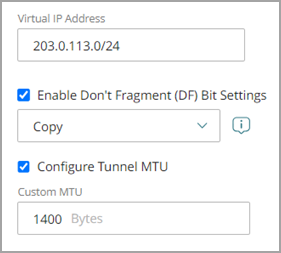
- Click Save.
The BOVPN changes deploy automatically for both Fireboxes to download. The BOVPN deployment is added to the Deployment History for both Fireboxes.
Edit or Delete a BOVPN
You can edit or delete a BOVPN from the BOVPN page. For information, go to Manage BOVPNs for Cloud-Managed Fireboxes.
Manage Device Configuration Deployment
Configure a BOVPN to a Locally-Managed Firebox or Third-Party VPN Endpoint
